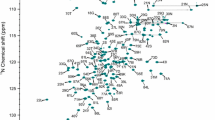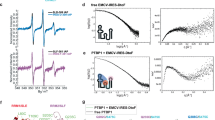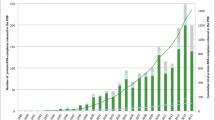Abstract
Human antigen R (HuR) functions as a major post-transcriptional regulator of gene expression through its RNA-binding activity. HuR is composed by three RNA recognition motifs, namely RRM1, RRM2, and RRM3. The two N-terminal RRM domains are disposed in tandem and contribute mostly to HuR interaction with adenine and uracil-rich elements (ARE) in mRNA. Here, we used a combination of NMR and electrospray ionization–ion mobility spectrometry–mass spectrometry (ESI–IMS–MS) to characterize the structure, dynamics, RNA recognition, and dimerization of HuR RRM1. Our solution structure reveals a canonical RRM fold containing a 19-residue, intrinsically disordered N-terminal extension, which is not involved in RNA binding. NMR titration results confirm the primary RNA-binding site to the two central β-strands, β1 and β3, for a cyclooxygenase 2 (Cox2) ARE I-derived, 7-nucleotide RNA ligand. We show by 15N relaxation that, in addition to the N- and C-termini, the β2–β3 loop undergoes fast backbone dynamics (ps–ns) both in the free and RNA-bound state, indicating that no structural ordering happens upon RNA interaction. ESI–IMS–MS reveals that HuR RRM1 dimerizes, however dimer population represents a minority. Dimerization occurs via the α-helical surface, which is oppositely orientated to the RNA-binding β-sheet. By using a DNA analog of the Cox2 ARE I, we show that DNA binding stabilizes HuR RRM1 monomer and shifts the monomer–dimer equilibrium toward the monomeric species. Altogether, our results deepen the current understanding of the mechanism of RNA recognition employed by HuR.





Similar content being viewed by others
References
Afroz T, Cienikova Z, Cléry A, Allain FHT (2015) One, two, three, four! How multiple RRMs read the genome sequence. Methods Enzymol 558:235–278
Barbato G, Ikura M, Kay LE, Pastor RW, Bax A (1992) Backbone dynamics of calmodulin studied by 15N relaxation using inverse detected two-dimensional NMR spectroscopy: the central helix is flexible. Biochemistry 31:5269–5278
Barreau C, Paillard L, Osborne HB (2006) AU-rich elements and associated factors: are there unifying principles? Nucleic Acids Res 33:7138–7150
Benoit RM, Meisner NC, Kallen J, Graff P, Hemmig R, Cèbe R, Ostermeier C, Widmer H, Auer M (2010) The X-ray crystal structure of the first RNA recognition motif and site-directed mutagenesis suggest a possible HuR redox sensing mechanism. J Mol Biol 397:1231–1244
Bevilacqua A, Ceriani MC, Capaccioli S, Nicolini A (2003) Post-transcriptional regulation of gene expression by degradation of messenger RNAs. J Cell Physiol 195:356–372
Blanco FF, Preet R, Aguado A, Vishwakarma V, Stevens LE, Vyas A, Padhye S, Xu L, Weir SJ, Anant S, Meisner-Kober N, Brody JR, Dizon DA (2016) Impact of HuR inhibition by the small molecule MS-444 on colorectal cancer cell tumorigenesis. Oncotarget 7:74043–74058
Blatter M, Dunin-Horkawicz S, Grishina I, Maris C, Thore S, Maier T, Bindereif A, Bujnicki JM, Allain FHT (2015) The signature of the five-stranded vRRM fold defines by functional, structural and computational analysis of the hnRNP L protein. J Mol Biol 427:3001–3022
Blaxall BC, Dwyer-Nield LD, Bauer AK, Bohlmeyer TJ, Malkinson Am, Port JD (2000) Differential expression and localization of the mRNA binding proteins, AU-rich element mRNA binding protein (AUF1) and Hu antigen R (HuR), in neoplastic lung tissue. Mol Carcinog 28:76–83
Brennan CM, Steitz JA (2001) HuR and mRNA stability. Cell Mol Life Sci 58:266–277 (2001)
Brunger AT (2007) Version 1.2 of the crystallographic and NMR system. Nat Protoc 2:2728–2733
Buchan JR, Parker R (2009) Eukaryotic stress granules: the ins and outs of translation. Mol Cell 36:932–941
Cléry A, Blatter M, Allain FHT (2008) RNA recognition motifs: boring? Not quite. Curr Opin Struct Biol 18:290–298
Cléry A, Jayne S, Benderska N, Dominguez C, Stamm S, Allain FHT (2011) Molecular basis of purine-rich RNA recognition by the human SR-like protein Tra2-beta 1. Nat Struct Mol Biol 18:443–450
Cléry A, Sinha R, Anczuków O, Corrionero A, Moursy A, Daubner GM, Valcárcel J, Krainer AR, Allain FHT (2013) Isolated pseudo-RRM-recognition motifs of SR proteins can regulate splicing using a noncanonical mode of RNA recognition. Proc Natl Acad Sci USA 110:E2802–E2811
Corsini L, Hothorn M, Stier G, Rybin V, Scheffzek K, Gibson TJ, Sattler M (2009) Dimerization and protein binding specificity of the U2AF homology motif of the splicing factor Pub60. J Biol Chem 284:630–639
Dean JLE, Wait R, Mahtani KR, Sully G, Clark AR, Sklatvala J (2001) The 3′-untranslated region of tumor necrosis factor alpha mRNA is a target of the mRNA-stabilizing factor HuR. Mol Cell Biol 21:721–730
Delaglio F, Grzesiek S, Vuister GW, Zhu G, Pfeifer J, Bax A (1995) NMRPipe: a multidimensional spectral processing system based on UNIX pipes. J Biomol NMR 6:277–293
DeLano WL (2002) The PyMol molecular graphics system. http://www.pymol.org
Denkert C, Weichert W, Winzer KJ, Muller BM, Noske A, Niesporek A, Kristiansen G, Guski H, Dietel M, Hauptmann S (2004a) Expression of the ELAV-like protein HuR is associated with tumor grade and increased cyclooxygenase-2 expression in human breast carcinoma. Clin Cancer Res 64:5580–5586
Denkert C, Weichert W, Pest S, Koch I, Licht D, Köbel M, Reles A, Sehouli J, Dietel M, Hauptmann S (2004b) Overexpression of the embryonic-lethal abnormal vision-like protein HuR in ovarian carcinoma is a prognostic factor and is associated with increased cyclooxygenase 2 expression. Cancer Res 64:189–195
Díaz-Quintana A, García-Mauriño SM, Díaz-Moreno I (2015) Dimerization model of the C-terminal RNA recognition motif of HuR. FEBS Lett 589:1059–1066
Doller A, Pfeilschifter J, Eberhardt W (2008) Signalling pathways regulating nucleo-cytoplasmic shuttling of the mRNA-binding protein HuR. Cell Signal 20:2165–2173
Domingues MN, Sforça ML, Soprano AS, Lee J, de Souza TACB, Cassago A, Portugal RV, de Mattos Zeri AC, Murakami MT, Sadanandom A, de Oliveira PSL, Benedetti CE (2015) Structure and mechanism of dimer-monomer transition of a plant poly(A)-binding protein upon RNA interaction: insights into its poly(A) tail assembly. J Mol Biol 427:2491–2506
Duviganud JB, Bédard M, Nagata T, Muto Y, Yokoyama S, Gagné SM, Vincent M (2016) Structure, dynamics, and interaction of p54(nrb)/NonO RRM1 with r’ splice site RNA sequence. Biochemistry 10:2553–2566
Eichhorn CD, Chug R, Feigon J (2016) hLARP7 C-terminal domain contains an xRRM that binds the 3′ hairpin of 7SK RNA. Nucleic Acids Res 44:9977–9989
Fan XC, Steitz JA (1999) Overexpression of HuR, a nuclear-cytoplasmic shuttling protein, increases the in vivo stability of ARE-containing mRNAs. EMBO J 17:3448–3460
Farrow NA, Muhandiram R, Singer AU, Pascal SM, Kay CM, Gish G, Shoelson SE, Pawson T, Forman-Kay JD, Kay LE (1994) Backbone dynamics of a free and a phosphopeptide-complexed Src homolofy 2 domain studied by 15N NMR relaxation. Biochemistry 33:5984–6003
Giaginis C, Alexandrou P, Tsoukalas N, Sfiniadakis I, Kavantzas N, Agapitos E, Patsouris E, Theocharis S (2015) Hu-antigen receptor (HuR) and cyclooxygenase-2 (COX-2) expression in human non-small-cell lung carcinoma: associations with clinicopathological parameters, tumor proliferative capacity and patient’s survival. Tumour Biol 36:315–327
Glisovic T, Bachorik JL, Yong J, Dreyfuss G (2008) RNA-binding proteins and post-transcriptional gene regulation. FEBS Lett 582:1977–1986
Hinman MN, Lou H (2008) Diverse molecular functions of Hu proteins. Cell Mol Life Sci 65:3168–3181
Hom RA, Chang PY, Roy S, Musselman CA, Glass KC, Selezneva AI, Gozani O, Ismagilov RF, Cleary ML, Kutateladze TG (2010) Molecular mechanism of MLL PHD3 and RNA recognition by the Cyp33 RRM domain. J Mol Biol 400:145–154
Izquierdo JM (2008) Hu antigen R (HuR) functions as an alternative pre-mRNA splicing regulator of Fas apoptosis-promoting receptor on exon definition. J Biol Chem 283:19077–19084
Joshi A, Coelho MB, Kotik-kohan O, Simpson PJ, Matthews SJ, Smith CW, Curry S (2011) Crystallographic analysis of polypyrimidine tract-binding protein-Raver 1 interactions involved in regulation of alternative splicing. Structure 19:1816–1825
Joshi A, Esteve V, Buckroyd AN, Blatter M, Allain FHT, Curry S (2014) Solution and crystal structures of a C-terminal fragment of the neuronal isoform of the polypyrimidine tract binding protein (nPTB). Peer J 2:e305
Kasashima K, Sakashita E, Saito K, Sakamoto H (2002) Complex formation of the neuron-specific ELAV-like Hu RNA binding proteins. Nucleic Acids Res 30:4519–4526
Katahira M, Miyanoiri Y, Enokizono Y, Matsuda G, Nagata T, Ishikawa F, Usegi S (2001) Structure of the C-terminal RNA-binding domain of hnRNP D0 (AUF1), its interactions with RNA and DNA, and change in backbone dynamics upon complex formation with DNA. J Mol Biol 311:973–988
Kay LE, Torchia DA, Bax A (1989) Backbone dynamics of proteins as studied by 15N inverse detected heteronuclear NMR spectroscopy: application to staphylococcal nuclease. Biochemistry 28:8972–8979
Kim HS, Headey SJ, Yoga YM, Scanlon MJ, Gorospe M, Wilce MC, Wilce JA (2013) Distinct binding properties of TIAR RRMs and linker region. RNA Biol 10:579–589
Koradi R, Billeter M, Wüthrich K (1996) MOLMOL: a program for display and analysis of macromolecular structures. J Mol Graph 14:51–55
Kuwasako K, Nameki N, Tsuda K, Takahashi M, Sato A, Tochio N, Inoue M, Terada T, Kigawa T, Kobayashi N, Shirouzu M, Ito T, Sakamoto T, Wakamatsu K, Güntert P, Takahashi S, Yokoyama S, Muto Y (2017) Solution structure of the first RNA recognition motif domain of human spliceosomal protein SF3b49 and its mode of interaction with SF3b145 fragment. Protein Sci 26:280–291
Linge JP, Williams MA, Spronk CA, Bonvin AM, Nilges M (2003) Refinement of protein structures in explicit solvent. Proteins 50:496–506
Linger JP, O’Donoghue SI, Nilges M (2001) Automated assignment of ambiguous overhauser effects with ARIA. Methods Enzymol 339:71–90
López de Silanes, I, Lal A, Gorospe M (2005) HuR: post-transcriptional paths to malignancy. RNA Biol 2:11–13
López de Silanes I, Fan J, Yang X, Zonderman AB, Potapova O, Pizer ES, Gorospe M (2003) Role of the RNA-binding platform HuR in colon carcinogenesis. Oncogene 22:7146–7154
Meisner NC, Hintersteiner M, Mueller K, Bauer R, Seifert JM, Naegeli HU, Ottl J, Oberer L, Guenat C, Moss S, Harrer N, Woisetschlaeger M, Buehler C, Uhl V, Auer M (2007) Identification and mechanistic characterization of low-molecular-weight inhibitors for HuR. Nat Chem Biol 3:508–515
Meisner NC, Hintersteiner M, Seifert JM, Bauer R, Benoit RM, Widmer A, Schindler T, Uhl V, Lang M, Gstach H, Auer M (2009) Terminal adenosyl transferase activity of posttranscriptional regulator HuR revealed by confocal on-bead screening. J Mol Biol 386:435–450
Migone F, Gissi C, Liuni S, Pesole G (2002) Untranslated regions of mRNAs. Genome Biol 3:reviews0004.1-0004.10
Moore M (2005) From birth to death: the complex lives of eukaryotic mRNAs. Science 309:1514–1518
Mujo A, Lixa C, Carneiro LA, Anobom CD, Almeida FC, Pinheiro, A (2015) S. 1H, 15N and 13C resonance assignments of the RRM1 domain of the key post-transcriptional regulator HuR. Biomol NMR Assign 9:281–284
Murachelli AG, Ebert J, Basquin C, Le Hir H, Conti E (2012) The structure of the ASAP core complex reveals the existence of a Pinin-containing PSAP complex. Nat Struct Mol Biol 19:378–386 (2012)
Myer VE, Fan XC, Steitz JA (1997) Identification of HuR as a protein implicated in AUUUA-mediated mRNA decay. EMBO J 16:2130–2139
Rieping W, Habeck M, Bardiaux B, Bernard A, Malliavin TE, Nilges M (2007) ARIA2: automated NOE assignment and data integration in NMR structure calculation. Bioinformatics 23:381–382
Samatanga B, Cléry A, Barraud P, Allain FHT, Jelesarov I (2017) Comparative analysis of the thermodynamics RNA binding sigantures of different types of RNA recognition motifs. Nucleic Acids Res 45:6037–6050
Schelhorn C, Gordon JM, Ruiz L, Alguacil J, Pedroso E, Macias MJ (2014) RNA recognition and self-association of CPEB4 is mediated by its tandem RMM domains. Nucleic Acids Res 42:10185–10195
Sheiba RM, de Opakua AI, Díaz-Quintana A, Cruz-Gallardo I, Matínez-Cruz LA, Martínez-Chantar ML, Blanco FJ, Díaz-Moreno I (2014) The C-terminal binding motif of HuR is a multi-functional domain leading to HuR oligomerization and binding to U-rich RNA targets. RNA Biol 11:1250–1261
Shen Y, Bax A (2013) Protein backbone and sidechain torsion angles predicted from NMR chemical shifts using artificial neural networks. J Biomol NMR 56:227–241
Singh M, Wang Z, Koo BK, Patel A, Cascio D, Collins K, Feigon J (2012) Structural basis for telomerase RNA recognition and RNP assembly by the holoenzyme La family protein p65. Mol Cell 47:16–26
Singh M, Choi CP, Feigon J (2013) xRRM: a new class of RRM found in the telomerase La family protein p65. RNA Biol 10:353–359
Song J, McGivern JV, Nichols KW, Markley JL, Sheets MD (2008) Structural basis for RNA recognition by a type II poly(A)-binding protein. Proc Natl Acad Sci USA 105:15317–15322
Song Z, Wu P, Ji P, Zhang J, Gong Q, Wu J, Shi Y (2012) Solution structure of the second RRM domain of RBM5 and its unusual binding characters for different RNA targets. Biochemistry 51:6667–6678
Soufari H, Mackereth CD (2017) Conserved binding of GCAC motifs by MEC-8, couch potato, and the RBPMS protein family. RNA 23:308–316
Stone MJ, Fairbrother WJ, Palmer III, Reizer AG, Saier J Jr, M. H. & Wright PE (1992) Backbone dynamics of the Bacillus subtilis glucose permease IIA domain determined from 15N NMR relaxation measurements. Biochemistry 31:4394–4406
Tsuda K, Kuwasako K, Nagata T, Takahashi M, Kigawa T, Kobayashi N, Güntert P, Shirouzu M, Yokoyama S, Muto Y (2014) Novel RNA recognition motif domain in the cytoplasmic polyadenylation element binding protein 3. Proteins 82:2879–2886
Vranken WF, Boucher W, Stevens TJ, Fogh RH, Pajon A, Llinas M, Ulrich EL, Markley JL, Ionides J, Laue E (2005) D. The CCPN data model for NMR spectroscopy: development of a software pipeline. Proteins 59:687–696
Wang H, Zeng F, Liu Q, Liu H, Liu Z, Niu L, Teng M, Li X (2013) The structure of the ARE-binding domains of Hu antigen R (HuR) undergoes conformational changes during RNA binding. Acta Crystallogr D 69:373–380
Wang I, Hennig J, Jagtap PK, Sonntag M, Valcárcel J, Sattler M (2014) Structure, dynamics, and RNA binding of the multi-domain splicing factor TIA-1. Nucleic Acids Res 42:5949–5966
Williams JP, Lough JA, Campuzano I, Richardson K, Sadler PJ (2009) Use of ion mobility mass spectrometry and a collision cross-section algorithm to study organometallic ruthenium anticancer complex and its adducts with a DNA oligonucleotide. Rapid Commun Mass Spectrom 23:3563–3569
Wilusz CJ, Wilusz J (2004) Bringing the role of mRNA decay in the control of gene expression into focus. Trends Genet 20:491–497
Zhang J, Gonzalez, Hall TMT (2017) Structural analysis reveals the flexible C-terminus of Nop15 undergoes rearrangement to recognize a pre-ribosomal RNA folding intermediate. Nucleic Acids Res 45:2829–2837
Zhu H, Zhou HL, Hasman RA, Lou H (2007) Hu proteins regulate polyadenylation by blocking sites containing U-rich sequences. J Biol Chem 282:2203–2210
Zhu Z, Wang B, Bi J, Zhang C, Guo Y, Chu H, Liang X, Zhong C, Wang J (2013) Cytoplasmic HuR expression correlates with P-gp, HER-2 positivity, and poor outcome in breast cancer. Tumour Biol 34:2299–2308
Acknowledgements
We would like to thank the staff of the UEMP-IBqM-UFRJ (Proteomic/Mass Spectrometry Platform) and the CNRMN-UFRJ (NMR Platform) for providing access to their facilities and excellent technical support. This work was supported by grants from Fundação Carlos Chagas Filho de Amparo à Pesquisa do Estado do Rio de Janeiro (FAPERJ), Conselho Nacional Científico e Tecnológico (CNPq), and by a Brazil Initiative Collaboration Grant from Brown University to ASP. CL is recipient of a Fundação Carlos Chagas Filho de Amparo à Pesquisa do Estado do Rio de Janeiro (FAPERJ) “outstanding student” graduate fellowship.
Author information
Authors and Affiliations
Corresponding author
Ethics declarations
Conflict of interest
The authors declare that they have no conflict of interest.
Electronic supplementary material
Below is the link to the electronic supplementary material.
Rights and permissions
About this article
Cite this article
Lixa, C., Mujo, A., de Magalhães, M.T.Q. et al. Oligomeric transition and dynamics of RNA binding by the HuR RRM1 domain in solution. J Biomol NMR 72, 179–192 (2018). https://doi.org/10.1007/s10858-018-0217-y
Received:
Accepted:
Published:
Issue Date:
DOI: https://doi.org/10.1007/s10858-018-0217-y




